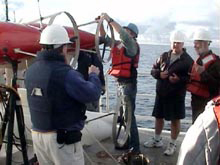
Al Duester, Rod Catanach, Phil Smith, and Al Bradley (left to right) prepare ABE for its next dive. Click image for larger view.
A Day in the Life at Sea
July 6, 2002
Bill Chadwick
Geologist
Vents Program, Pacific Marine Environmental Laboratory, NOAA
![]() Watch a video of ABE surveying the seafloor. (mp4, 8.4 MB)
Watch a video of ABE surveying the seafloor. (mp4, 8.4 MB)
The daily rhythm of events during this expedition is continuous and fluid. Plans for specific operations are made hours to days in advance, and then continually adjusted and modified as circumstances warrant. The schedule is kept as flexible as possible to take advantage of unanticipated opportunities and to maximize the efficiency of the 24-hour-a-day operations of the ship. Because of the continuous operations, hours merge into days, and days into weeks without the usual pauses that accompany shore-based life and work. At sea, operations proceed around the clock, which makes planning and scheduling important.
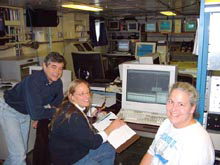
Ed Baker, Kristen Anderson and Sharon Walker (left to right) monitor data during a CTD cast, looking for evidence of hydrothermal plumes in the water column above Explorer Ridge. Click image for larger view.
On this expedition, our schedule revolves around the use of our two primary scientific tools—the CTD and ABE. During each dive, ABE may spend about 12 to 14 hours on the bottom. Between dives, it needs about the same amount of time to recharge its batteries. It takes about two hours to get to the bottom and the same to get back. Because we want to use ABE as much as possible, and its schedule is somewhat structured and predictable, our other exploration tasks tend to be scheduled around it. The following are the events of a typical day, from midnight to midnight.
00:00 - ABE is launched for another dive in the Magic Mountain area, and we use acoustic tracking to confirm that it has successfully reached the bottom and has started its next mapping mission.
02:00 - The Thompson departs the area and heads to the northeast at 10 knots. We are going to a series of deep basins at the northeastern end of Explorer Ridge, where it splits into two diverging segments, like the letter Y. One aim of the expedition is to survey the entire length of Explorer Ridge with the CTD to find hydrothermal plumes, and we have not yet explored this part of the ridge.
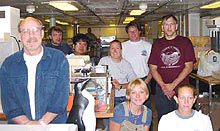
Ron Greene, Maurice Tivey, Koichi Nakamura, Andrea Toth, Geoff Lebon, Angela Opiola, Joe Resing and Maureen Carr (left to right) at work in the main lab on the Thompson, where water samples from the CTD operations are analyzed. Click image for larger view.
The CTD sites are 30 miles away. So during the transit, we collect multibeam bathymetry with the Thompson's new EM300 system, which has better navigation and more resolution than previous systems. As we drive along a pre-determined survey line, we map the depth of the seafloor within a swath that is about 5 to 6 km wide. By collecting data in a grid pattern with the swaths slightly overlapping, large areas can be surveyed in a way similar to mowing a lawn. During this expedition, we are gradually remapping the entire Explorer Ridge, which allows us to better “see” potential targets for more detailed exploration on the seafloor. The transit and multibeam survey take three hours.
05:00 - At the location of the first of three CTD casts, the ship stops and the CTD is put over the side. As the CTD is lowered through the water column via cable, it sends back data from several sensors. Scientists in the lab note any sudden changes in water temperature and/or cloudiness (turbidity) that signal the presence of a hydrothermal plume. The CTD descends to about 20 meters above the seafloor before beginning its ascent back to the surface. During the ascent, water samples are taken using large PVC Niskin-type bottles that close on demand from the surface. Water samples are taken within any plumes found. As soon as the CTD lands on deck, scientists begin drawing water for preservation and analyses either at sea or later in the lab. Subsamples are taken for at least ten separate analyses of the dissolved and particulate elements and gases.
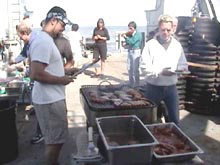
The Thompson's galley crew provided a Fourth of July picnic on the back deck of the Thompson. In the left foreground, Shawn Lindenmuth serves up the barbeque. Charlie Leahey provided violin music (background). Even the north Pacific weather cooperated, with temperatures in the 70s. Click image for larger view.
Each CTD cast takes two hours. Between the three CTD casts, additional multibeam bathymetry is collected during the two-hour transits. Breakfast falls between the first two casts, and lunch between the last two. Meanwhile, data from the previous ABE dive are being processed and analyzed on board. In addition, plans are being discussed for the next ABE dive.
15:00 - Eventually, it is time to return to the site of the current ABE dive. We must anticipate when ABE will end its survey and start returning to the surface, so that the Thompson will be there to recover it. The transit time back is three hours, and we collect another line of multibeam bathymetry. We eat dinner during this transit.
18:00 - The Thompson arrives at the dive site just as ABE is leaving the bottom. Acoustic tracking is used to follow ABE during its ascent.
20:00 - Once ABE is on the surface, the ship moves alongside and brings it on board. Immediately, computer cables are hooked up to the vehicle and data begins to be downloaded to computers in one of the Thompson's labs. The data from the ABE dive are quickly reviewed, and then more detailed processing begins. The batteries are charged.
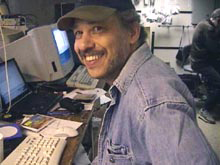
Dana Yoerger examines data from the many scientific sensors on ABE, only minutes after the vehicle is recovered. Click image for larger view.
21:00 - The next task is to recover one acoustic transponder in the navigation network that ABE has been using and replace it with another. This particular transponder has not been working well. The acoustic release code is sent as soon as ABE is on deck. It takes about an hour for the transponder to come to the surface and the ship to recover it.
22:00 - Next, a new transponder is deployed off the stern at a slightly different location. It takes two hours to survey it in. And in what seems like the blink of an eye, it is midnight of another day.
Sign up for the Ocean Explorer E-mail Update List.






















